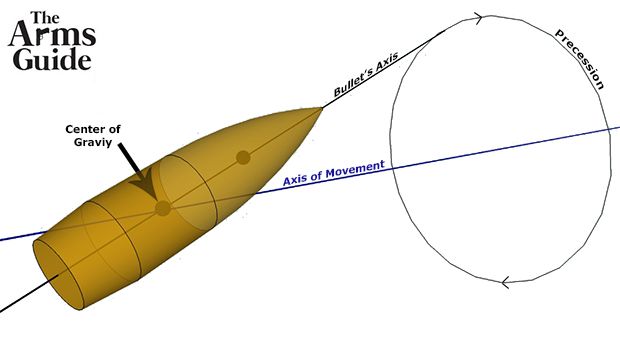If you want to be a proficient in long range shooting, understanding the concept of dynamic stability is very important if you want to place accurate shots at the farthest distance possible, especially if you are shooting close to the maximum effective distance of your rifle. In this article, we’ll see how dynamic stabilization affects bullet flight and accuracy, and how to obtain a proper dynamic stabilization from your weapon system.
As we have learned in the static stability article, the bullet needs to be stabilized, via spinning, to prevent it from tumbling. Unfortunately, the gyroscopic motion is itself a cause of instability, because of the related phenomenon of gyroscopic precession. Indeed, due to precession, when the bullet leaves the muzzle, it always has a wobbling motion.
The tip of the bullet actually draws a cone around the axis of movement, with the tip of the cone on the center of gravity of the bullet. This is a consequence of imperfections in bullet construction (such as lead void or jacket thickness differences) which imbalance its center of gravity. It’s also a consequence of the lack of concentricity between the bullet axis and the axis of movement, due to the bullet travelling down the barrel with its tip not aligned with the barrel centerline. It is the same reason why cars’ wheels need to be balanced with lead weights. If they have imperfect weight distribution or axis alignment when the car is travelling at speed, and wheels are spinning, they wobble due to precession, and the car vibrates. In addition, the bullet tip doesn’t create perfect circles during its precession. Instead, it constantly swerves because of nutation, another phenomenon of gyroscopic motion.
Eventually, when the bullet travels downrange, these motions are damped out with distance by the action of the air flow pushing along the bullet surface. In this case, the bullet is dynamically stabilized.
Interested in building your own AR-15 rifle? Check out our beginners guide here
Some phrase it that the bullet “goes to sleep.” If the wobbling is not damped out, the bullet is not dynamically stabilized, and beyond being less accurate, the bullet can tumble. In a future article, we’ll see how major issues will occur as the bullet passes through the transonic region.
The amount of dynamic instability is a function of bullet length and the spin rate. Longer bullets, and bullets with higher spin rates, have higher degrees of wobble and are the most difficult to stabilize. Unlike static stability, we cannot predict dynamic stability. There is a formula to calculate the dynamic stability factor (Sd), but we’d need to know too many variables, many of them impossible to obtain outside of a lab with specific equipment.
What we can do is to minimize the problem by selecting the right bullet for our specific barrel and barrel twist, ensuring an adequate static stability factor while avoiding unnecessarily high spin rates. Also, we can select high quality bullets, which helps us to avoid as much internal imperfection as possible. We can also try to ensure as much concentricity. There are several ways we can do this, most of them related to handloading. A common practice, useful both with hand loaded and commercial ammo, is to gauge the runout between the bullet axis and the case axis, selecting only the rounds with a lower runout value, or adjusting the reloading equipment/process to obtain more concentric rounds. Usually, a runout of less than .010″ is considered acceptable, even though many competitive shooters set their standard to a max of .005 or less.
The gyroscopic motion, and in particular the related phenomenon of gyroscopic precession, is also the cause of spin drift, which we covered in Bullet Trajectory. If you want to see in detail how spin drift generates, stay tuned for the next article.


